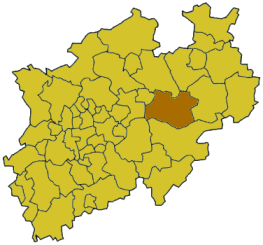Soest (district): Difference between revisions
m →External links: {{commonscat-inline|Kreis Soest}} |
Kwamikagami (talk | contribs) m rd IPA to language key using AWB |
||
| Line 13: | Line 13: | ||
map=North_rhine_w_so.png |
map=North_rhine_w_so.png |
||
}} |
}} |
||
'''Soest''' ({{IPA-de|ˈzoːst |
'''Soest''' ({{IPA-de|ˈzoːst|lang|De-Soest.ogg}}) is a [[Districts of Germany|Kreis]] (district) in the middle of [[North Rhine-Westphalia]], [[Germany]]. Neighboring districts are [[Warendorf (district)|Warendorf]], [[Gütersloh (district)|Gütersloh]], [[Paderborn (district)|Paderborn]], [[Hochsauerland]], [[Märkischer Kreis]], [[Unna (district)|Unna]] and the district-free city [[Hamm]]. |
||
==History== |
==History== |
||
| Line 51: | Line 51: | ||
#[[Wickede]] |
#[[Wickede]] |
||
|} |
|} |
||
==References== |
==References== |
||
{{Reflist}} |
{{Reflist}} |
||
Revision as of 11:58, 13 September 2011
Kreis Soest | |
|---|---|
 | |
| Country | Germany |
| State | North Rhine-Westphalia |
| Adm. region | Arnsberg |
| Capital | Soest |
| Area | |
| • Total | 1,327.47 km2 (512.54 sq mi) |
| Population (31 December 2023)[1] | |
| • Total | 306,674 |
| • Density | 230/km2 (600/sq mi) |
| Time zone | UTC+01:00 (CET) |
| • Summer (DST) | UTC+02:00 (CEST) |
| Vehicle registration | SO |
| Website | http://www.kreis-soest.de |
Soest (German: [ˈzoːst] ) is a Kreis (district) in the middle of North Rhine-Westphalia, Germany. Neighboring districts are Warendorf, Gütersloh, Paderborn, Hochsauerland, Märkischer Kreis, Unna and the district-free city Hamm.
History
In medieval times Soest was the biggest city of Westphalia; however, after it liberated itself from the bishops of Cologne in the Soester Fehde in 1449 it slowly lost importance, only to gain it again when in 1816 the new Prussian government created the district. In 1975 the district was merged with the neighboring district of Lippstadt and parts of the former district of Arnsberg.
Geography
Geographically it covers the northern part of the Sauerland hills and the lower land north of it, the 'Hellweg'. The rather flat land and very fertile loess soil have it an agricultural area from ancient times. The main rivers through the district are the Ruhr, the Lippe and the Möhne, which is dammed to form the Möhne Reservoir. The highest elevation is in the area of Warstein with 580m, while the lowest is the Lippe valley with 65m.
Coat of arms

|
The coat of arms show two symbols from the bishops of Cologne, who possessed Soest until 1449. In left half is the key of Saint Peter, the patron of Cologne; in the right is the black cross of Cologne. After the district was merged with Lippstadt the rose, symbol of the Lippe area, was added on top of the cross. This new version of the coat of arms was granted in 1976. |
Towns and municipalities
| Towns | Municipalities |
|---|---|
References
External links
Media related to Kreis Soest at Wikimedia Commons
- Official website (German, English)
